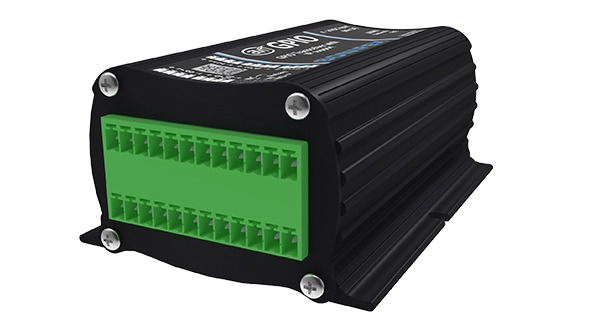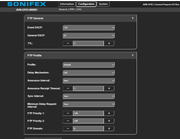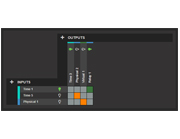AVN-GPIO GPIO LAN Transceiver (PTP, EMBER+ & UDP)
 |
||||
 |
 |
 |
 |
 |
Iso View |
Front View |
Rear View |
PTP Page |
Invert Routing |
AVN-GPIO GPIO LAN Transceiver (PTP, EMBER+ & UDP)
The AVN-GPIO is part of the AVN range of network interface boxes, which converts GPIO (General Purpose Inputs & Outputs) to network commands to control, and be controlled by, other equipment or software across a standard network.
It has 10 configurable GPIO’s, 8 of which can be used for PTP based programming, together with a relay. It provides virtual GPIO that allow the device to trigger or be triggered by other Sonifex devices on the network using virtual GPIO without the need for extra wiring (virtual GPIO communication occurs via the ethernet connection). Units can either be interfaced together across a network, or you can use Ember+ and UDP commands to accept commands from, or drive, the AVN-GPIO.
The AVN-GPIO is a PTP (Precision Time Protocol) enabled GPIO device. IEEE1588-2008 PTPv2 is used to keep a hardware clock in sync with a PTP master, such as the AVN-GMCS Grandmaster Clock, to achieve a sub 10ns synchronisation to the master reference. This means that the AVN-GPIO can be used to accurately timestamp input events and to trigger outputs at configured times.
The AVN-GPIO supports Default and AES67 Media profiles, and also provides a Custom profile which can be configured by the user.
It is housed in a rugged aluminium box with side slots for screw-mounting and is powered by PoE (Power over Ethernet).
The device is configured via a built-in webserver. This allows the configuration of PTP as well as live monitoring of its status. A GPIO routing webpage is provided which allows physical, timed, and virtual inputs to be routed to physical, timed, and virtual outputs.
The AVN-GPIO provides a simple UDP messaging system that allows other devices on the network to query the device status information, for example to retrieve the time at which a change in input occurred. Custom applications can also be written to query this information via UDP.
The device has 8 ‘timed’ GPIOs - when used as inputs these can detect the rising and falling edges and will generate a timestamp synced to the hardware PTP clock. This means that the recorded timestamps will be synced within 10ns of the PTP master in a correctly setup system. When setup as outputs, a signal can be generated precisely at a time chosen by you and the time at which the output toggles can be configured down to the nanosecond. Alternatively, these timed GPIOs can be configured to act as ‘normal’ GPIOs depending on your application.
There are also two ‘normal’ GPIOs. When normal GPIOs are configured as inputs they can be set to either momentary or latching mode. When setup as outputs, they pull the signal on the GPO pin down to ground when active.
The AVN-GPIO has a voltage free relay contact that can be used to operate external equipment, and also provides 6 x DC output voltage pins that can be used to power external equipment such as signage and various sensors and actuators. When powered via PoE (Power over Ethernet) the AVN-GPIO outputs 12V at 300mA total on these pins. When powered via the DC input the AVN-GPIO provides 1A total on these pins, and the voltage follows the DC input. The DC outputs are fused to prevent drawing more current than the device can provide and these fuses are automatically reset when the device is power cycled.
- 10 assignable GPIOs, 8 of which are PTP enabled.
- PTPv2 keeps the hardware clock in sync with a PTP master to achieve a sub 10ns accuracy.
- Single voltage free relay contact to operate external equipment.
- Virtual GPIO for sending physical GPIO action commands across a network.
- A single cable can be used for both power and control.
- The built-in webserver makes the AVN-GPIO easy to configure and allows it to be controlled by any device with a web browser.
- It can provide power to other devices via DC outputs.
- Uses Ember+ and UDP for communication, allowing programs to be written to interface with it.
- A PTP synced hardware clock ensures that when recording input events, even from two AVN-GPIOs a large distance away from each other, the timings are highly accurate (<10ns) with respect to one-another.
- It allows highly accurate activation of outputs - two outputs kilometres away from each other could be triggered with only a few nanoseconds difference when PTP synced.
Applications
- Motor racing timing: PTP enabled time outputs can be used to start a race at a specified time, then PTP enabled time inputs can be used to accurately record the time when cars pass the finish line with a nanosecond resolution. The results can be queried via UDP messages with a history of previous recordings also stored for querying.
- To connect legacy equipment, with only hardware I/O, to a network for remote control purposes. There are many Redbox units with hardware remotes that could now be controlled over a network, for example, the RB-DD4, RB-SD1 or RB-OA3.
- Button presses can be converted to network commands, for example to act as inputs to software for event handling, or to control remote equipment.
- Inputs from mechanical buttons & switches, or devices, can control lights and equipment connected to the AVN-GPIO across a network.
- Timed control switching, e.g. switching lights on/off at specific times of the day, reconfiguring which light switch turns on/off which light and/or controlling light on/off via a webpage.
- Time control of power on/off to test equipment and heating systems, together with providing times at which tests are passed.
- Controlling the power for other equipment at unattended/remote locations, whilst logging precise event data. (e.g. unattended weather stations).
- Configuring automated systems, controlling conveyor belts, turning on/off machinery.
- Notification system for a control room, to indicate an area that needs inspection which can be connected to alarm/bell.
- Signal detection on a Sonifex AVN-CU2/4 commentary unit can be linked to a virtual GPO which is then used as an input to the AVN-GPIO.
- A physical input to an AVN-GPIO can be routed to a virtual GP output, which could be a virtual input on the AVN-CU2/4. This could be used to change the commentator on/off air status, turn on/off ducking, or mute/unmute commentator as examples.
- A physical input to an AVN-GPIO can be routed to a virtual output, to act as a virtual input on a Sonifex AVN-Portal which can be used to mute/unmute a mix-point.
Technical Specification For AVN-GPIO |
|
PTP Timing Specification |
|
| Profile Support | IEEE 1588 Default Profile, AES67 Media & Customs Profile |
| Timing Protocol | PTPv2, IEEE 1588-2008 |
| Timing Accuracy | PTP time stamping resolution 8 nanoseconds |
Connections |
|
| Network | 1 x 100 Mbit/s Ethernet (RJ45/100BASE-TX) with Power over Ethernet (PoE) |
| DC Power In | 1 x 2.5mm locking DC inlet Centre pin positive |
| GPIO Connector | 1 x 24-Pin Phoenix Style Terminal Block |
| GPIO Format | 10 x GPIOs (8 x PTP enabled), configuarable as pull-low inputs or open collector outputs |
| Voltage Free Relay Contacts | NC, NO, Wiper |
| Relay Contacts Max Voltage | 125V (AC) |
| Relay Contacts Max Current | 600mA (AC) 2A (DC) |
Power over Ethernet (PoE) |
|
| Standard | IEEE 802.3af |
| Class | 0 |
| PD Power Range | 0.44 W to 12.94 W |
| Typical PSE Power Usage | 2.3W |
| Max PSE Power Usage | 15.4 W |
DC Power Out (Powered by PoE) |
|
| Voltage | 12V DC |
| Max Current: | 300mA |
DC Power In |
|
| Min Voltage | 4V DC |
| Max Voltage | 24V DC |
| Min external supply current | 2A |
DC Power Out (Powered by DC input) |
|
| Voltage | Follows DC Input |
| Max Current | 1A |
Ember+ Interface Connection |
|
| Interface Type | Provider and Consumer |
| Port | 9000 |
UDP Interface Connection |
|
| Port | 31780 |
Equipment Type |
|
| AVN-GPIO | GPIO LAN Transceiver (PTP, EMBER+ & UDP) |
Physical Specification |
|
Dimensions (Raw) |
10.6cm (W) x 7.3cm (D) x 4.3cm (H) 4.2" (W) x 2.9" (D) x 1.7" (H) |
Dimensions (Boxed) |
17.4cm (W) x 9.5cm (D) x 5.6cm (H) 6.9" (W) x 3.7" (D) x 2.2" (H) |
Weight |
Nett: 0.2kg Gross: 0.3kg Nett: 0.44lbs Gross' 0.66lbs |
